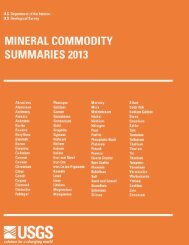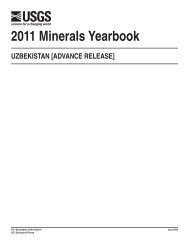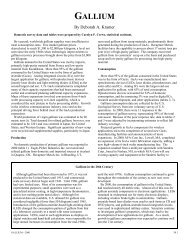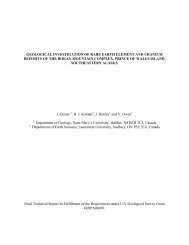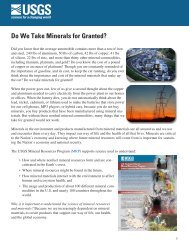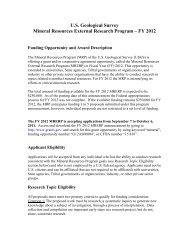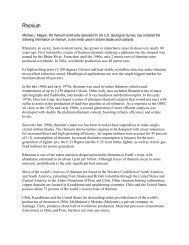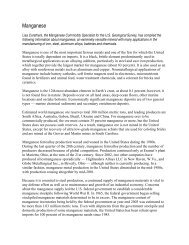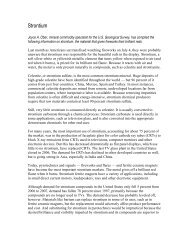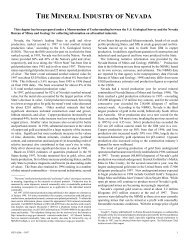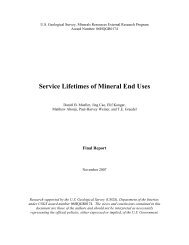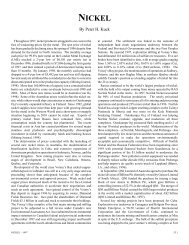Mineral Commodity Summaries 2003 - Mineral Resources Program ...
Mineral Commodity Summaries 2003 - Mineral Resources Program ...
Mineral Commodity Summaries 2003 - Mineral Resources Program ...
Create successful ePaper yourself
Turn your PDF publications into a flip-book with our unique Google optimized e-Paper software.
196<br />
(marginal reserves), and some of those that are<br />
currently subeconomic (subeconomic resources). The<br />
term “geologic reserve” has been applied by others<br />
generally to the reserve-base category, but it also may<br />
include the inferred-reserve-base category; it is not a<br />
part of this classification system.<br />
Inferred Reserve Base.—The in-place part of an<br />
identified resource from which inferred reserves are<br />
estimated. Quantitative estimates are based largely<br />
on knowledge of the geologic character of a deposit<br />
and for which there may be no samples or measurements.<br />
The estimates are based on an assumed<br />
continuity beyond the reserve base, for which there is<br />
geologic evidence.<br />
Reserves.—That part of the reserve base which could<br />
be economically extracted or produced at the time of<br />
determination. The term reserves need not signify<br />
that extraction facilities are in place and operative.<br />
Reserves include only recoverable materials; thus,<br />
terms such as “extractable reserves” and<br />
“recoverable reserves” are redundant and are not a<br />
part of this classification system.<br />
Marginal Reserves.—That part of the reserve base<br />
which, at the time of determination, borders on being<br />
economically producible. Its essential characteristic<br />
is economic uncertainty. Included are resources that<br />
would be producible, given postulated changes in<br />
economic or technological factors.<br />
Economic.—This term implies that profitable extraction<br />
or production under defined investment assumptions<br />
has been established, analytically demonstrated, or<br />
assumed with reasonable certainty.<br />
Subeconomic <strong>Resources</strong>.—The part of identified<br />
resources that does not meet the economic criteria of<br />
reserves and marginal reserves.<br />
Undiscovered <strong>Resources</strong>.—<strong>Resources</strong>, the existence<br />
of which are only postulated, comprising deposits that<br />
are separate from identified resources. Undiscovered<br />
resources may be postulated in deposits of such<br />
grade and physical location as to render them<br />
economic, marginally economic, or subeconomic. To<br />
reflect varying degrees of geologic certainty,<br />
undiscovered resources may be divided into two<br />
parts.<br />
Hypothetical <strong>Resources</strong>.—Undiscovered resources<br />
that are similar to known mineral bodies and that<br />
may be reasonably expected to exist in the same<br />
producing district or region under analogous<br />
geologic conditions. If exploration confirms their<br />
existence and reveals enough information about<br />
their quality, grade, and quantity, they will be<br />
reclassified as identified resources.<br />
Speculative <strong>Resources</strong>.—Undiscovered resources<br />
that may occur either in known types of deposits in<br />
favorable geologic settings where mineral<br />
discoveries have not been made, or in types of<br />
deposits as yet unrecognized for their economic<br />
potential. If exploration confirms their existence<br />
and reveals enough information about their<br />
quantity, grade, and quality, they will be reclassified<br />
as identified resources.<br />
Restricted <strong>Resources</strong>/Reserves.—That part of any<br />
resource/reserve category that is restricted from<br />
extraction by laws or regulations. For example,<br />
restricted reserves meet all the requirements of<br />
reserves except that they are restricted from<br />
extraction by laws or regulations.<br />
Other Occurrences.—Materials that are too low grade<br />
or for other reasons are not considered potentially<br />
economic, in the same sense as the defined<br />
resource, may be recognized and their magnitude<br />
estimated, but they are not classified as resources. A<br />
separate category, labeled other occurrences, is<br />
included in figures 1 and 2. In figure 1, the boundary<br />
between subeconomic and other occurrences is<br />
limited by the concept of current or potential feasibility<br />
of economic production, which is required by the<br />
definition of a resource. The boundary is obviously<br />
uncertain, but limits may be specified in terms of<br />
grade, quality, thickness, depth, percent extractable,<br />
or other economic-feasibility variables.<br />
Cumulative Production.—The amount of past<br />
cumulative production is not, by definition, a part of<br />
the resource. Nevertheless, a knowledge of what has<br />
been produced is important to an understanding of<br />
current resources, in terms of both the amount of past<br />
production and the amount of residual or remaining<br />
in-place resource. A separate space for cumulative<br />
production is shown in figure 1. Residual material left<br />
in the ground during current or future extraction<br />
should be recorded in the resource category<br />
appropriate to its economic-recovery potential.



